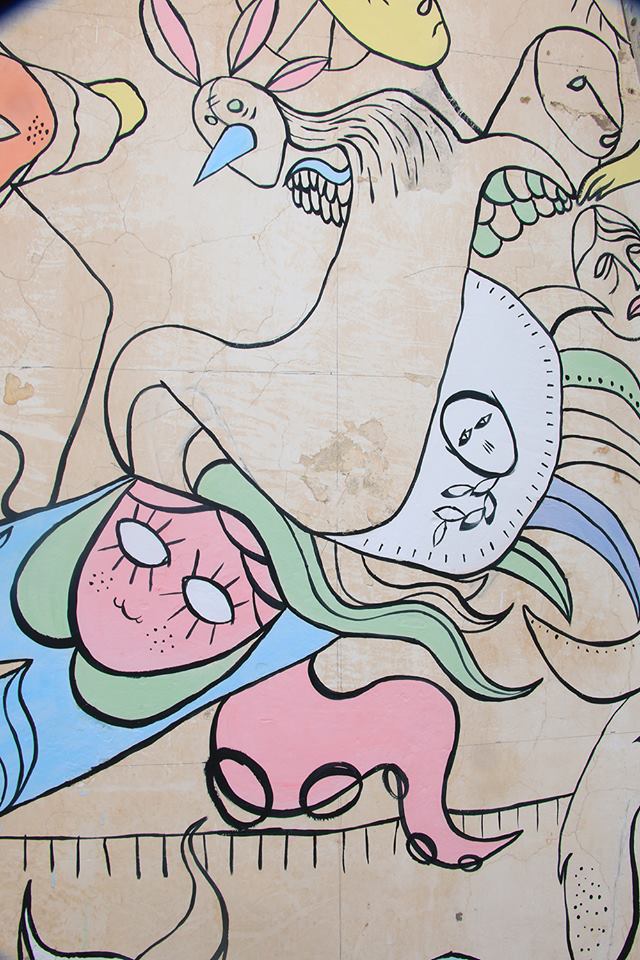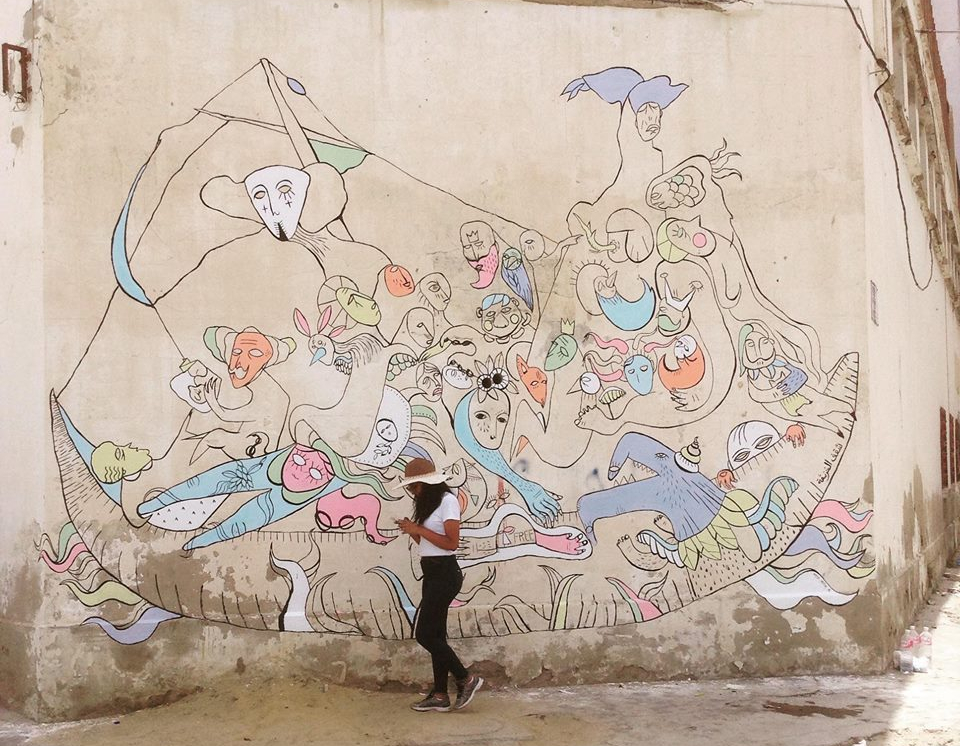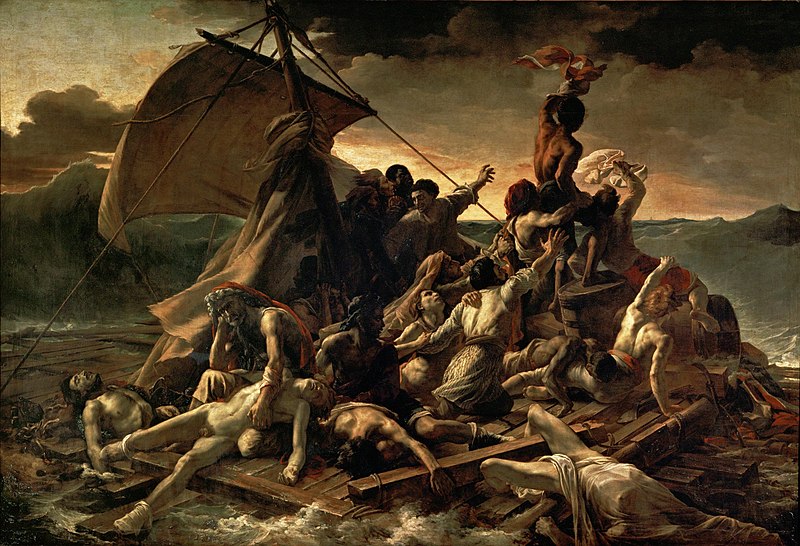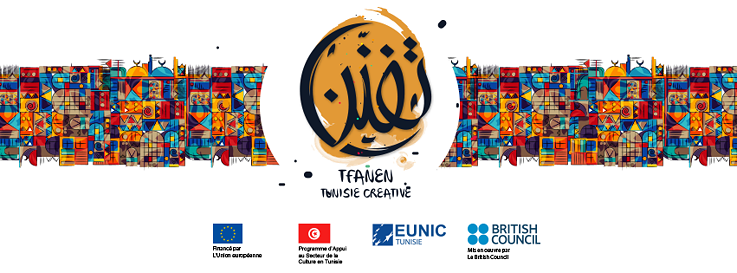
The Context:
This month Elbirou Art Gallery organized a city-wide public arts event called Utopies Visuelles (U.V) in Sousse, Tunisia. The event started on July 5th with a residency in which artists from inside and outside the country collaborated on artistic projects with students from the Higher Institute of Fine Arts of Sousse (ISBAS).
U.V is sponsored by Tfanen_Tunisie Créative, an EU fund.
Most of the UV artwork will be on display in the gallery until July 22, but some of it will continue to negotiate its place in the city beyond the event. Since many of the artists chose to paint large murals or glue giant stickers around the city, the question now is:
Will this artwork be vandalized or will it be lovingly kept and protected?
Despite the fact that some works were vandalized and others were even completely erased, I remain hopeful.
My hope is “neither loud nor naive,” but I have seen how local residents, especially children, participated in painting some of the murals that now grace the walls of Gabadji Sud. I have seen how they stenciled playful geometric patterns on the abandoned Rose Blanche (الوردة البيضاء) factory in the same neighborhood. I have heard the men thank the artists enthusiastically, and I have heard the women complain about vandalism. I know that the murals are loved by many.
I hope to return to the Gabadaji projects in more details some time in the future, but for the purposes of this blog, I would like to focus on the work of the Tunisian artist and ISBAS professor, Hela Lamine.
The Mural:

Hela Lamine’s contribution to Utopies Visuelles consisted of a mural entitled, “Shqaff al-Hurriga.” The mural can be seen on the sea-facing wall of the Comptoir National de Plastique (CNP) in Bhar al-Zibla (literally, the sea of garbage).
Bhar al-Zibla was originally called Borj Khadija. The area acquired its new name after parts of the neighborhood became a municipal landfill and (allegedly) a dumping ground for the National Sanitation Utility (ONAS). The Sousse municipality organized multiple cleaning campaigns in the area in recent years, but the neighborhood continues to have an insalubrious reputation.
Not far from the CNP building is a sales depot for alcoholic beverages frequented by the city’s poorer residents. The ill-kept houses in the neighborhood stand in stark contrast to the luxurious hotels a few hundred meters away. For Hela Lamine, no neighborhood could have been better suited to host the mural than Bhar al-Zibla. She tells me, “le lieu est pile-poil ce qu’il me fallait.”

“Shqaff al-Hurriga” is a tribute to the 150 lives lost in the undocumented migrant trip in Kerkennah this past June. Lamine’s mural is essentially a re-imagining of Géricault’s “The Raft of the Medusa” (1818-1819), exactly two hundred years later.
Just like in Kerkannah, the victims of the Medusa shipwreck were also 150 people.
Just like in Kerkannah, the victims were the poorest of the ship, the ones that the French captain chose to abandon in order to save the dignitaries and the politicians.
However, unlike the Kerkannah victims who were headed to the southern coasts of Europe, the French Medusa was headed to the western coasts of Africa to reclaim Sénegal from the British and to appoint a French governor on African soil. Two opposite routes. One long entangled history.

Lamine kept all the dimensions of the original painting, but radically changed the aesthetic. Unlike Géricault’s dark and dramatic rendition of the shipwreck, Lamine’s “Shqaff al-Hurriga” is a cartoonish re-interpretation of the tragedy. Perhaps a nod to the childhood dreams that sunk with the 150 lives we lost. Upon a closer look, however, the cartoonish pastel figures of the raft appear to be ghosts with hollowed eyes. Their bodies are malleable like jellyfish (hurriga). They melt into the background and disappear into the sea, replicating the fate of the harraga (undocumented migrants).
The choice of the simple line can also be an abstraction and a generalization of the fate of the migrants. As Scott McCloud tells us,

Perhaps, “we are all on the Raft of the Medusa,” as one contemporary of Géricault said about the painting.
Manufacturing Hope:

Lamine did not keep the rescuing ship that we see in Géricault’s work, but she did keep the iconic flag-waving figure of the original painting. The flag, a plea for recognition and a threadbare symbol of hope beckons the passers-by, the drinkers, the swimmers, and the alt-tourists to stop, contemplate, and remember.
The artist also says that she seeks to establish an “impossible dialogue between Géricault and the famous Medusa mosaics in the nearby Sousse Archeological Museum.” The Medusa with its petrifying gaze is _according to Herodotus_ a Libyan monster. Representations of her face in Roman Sousse were meant to prevent evil from entering one’s home. However, as the contentious history of the Mediterranean has shown us, this evil is impossible to prevent. All we can do is re-work and perfect our (shared) mythologies.
Shqaff al-Hurriga is an itinerant and participatory project. Three more versions of the mural will be painted in the next two months in Hammamet, Paris, and Geneva. More reproductions will be scheduled soon. With each new copy of the copy, Lamine wants to exhaust the meaning of the original painting. Each time also, new participants will help the artist color the mural. Locals, visitors, and passers-by will all be invited to take part in Shqaff al-Hurriga ‘s journey around the world.


Leave a comment